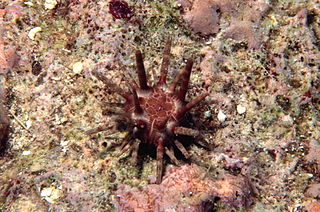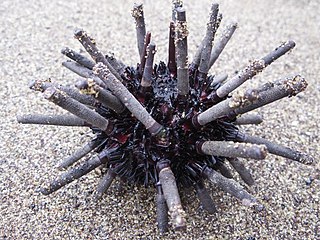
Sea urchins are spiny, globular echinoderms in the class Echinoidea. About 950 species of sea urchin are distributed on the seabeds of every ocean and inhabit every depth zone from the intertidal seashore down to 5,000 meters. The spherical, hard shells (tests) of sea urchins are round and covered in spines. Most urchin spines range in length from 3 to 10 cm, with outliers such as the black sea urchin possessing spines as long as 30 cm (12 in). Sea urchins move slowly, crawling with tube feet, and also propel themselves with their spines. Although algae are the primary diet, sea urchins also eat slow-moving (sessile) animals. Predators that eat sea urchins include a wide variety of fish, starfish, crabs, marine mammals, and humans.

Fernando de Noronha Marine National Park is a national park in the state of Pernambuco, Brazil.

Echinus esculentus, the European edible sea urchin or common sea urchin, is a species of marine invertebrate in the Echinidae family. It is found in coastal areas of western Europe down to a depth of 1,200 m (3,900 ft). It is considered "Near threatened" in the IUCN Red List of Threatened Species.

Arvoredo Marine Biological Reserve is a Biological reserve off the coast of the Santa Catarina state, Brazil.

Micromelo undatus, common name the miniature melo, is an uncommon species of small sea snail or bubble snail, a marine opisthobranch gastropod mollusk in the family Aplustridae.

Eucidaris tribuloides, the slate pencil urchin, is a species of cidaroid sea urchins that inhabits littoral regions of the Atlantic Ocean. As a member of the basal echinoid order Cidaroida, its morphological, developmental and molecular genetic characteristics make it a phylogenetically interesting species.
Slate pencil urchin is a common name for several sea urchin species with blunt spines:

Cidaridae is a family of sea urchins in the order Cidaroida.
Batheulima epixantha is a species of sea snail, a marine gastropod mollusc in the family Eulimidae.

Eulimacrostoma lutescens is a species of sea snail, a marine gastropod mollusk in the family Eulimidae.
Eulima mulata is a species of sea snail, a marine gastropod mollusk in the family Eulimidae. The species is one of a number within the genus Eulima.

Hypermastus orstomi is a species of sea snail, a marine gastropod mollusk in the family Eulimidae.

Eucidaris is a genus of cidaroid sea urchins known as slate pencil urchins. They are characterised by a moderately thick test, a usually monocyclic apical disc, perforate and non-crenulate tubercles and nearly straight ambulacra with horizontal pore pairs. The primary spines are few and widely spaced, stout with blunt flat tips and beaded ornamentation and the secondary spines are short and apressed. They originated in the Miocene and extant members of the genus are found in the tropical Indo-Pacific Ocean, East Pacific, Atlantic Ocean and Caribbean Sea.

Eucidaris metularia, the ten-lined urchin, is a species of sea urchins in the family Cidaridae. It is found in shallow parts of the Indo-Pacific Ocean and is characterised by its sparse covering of banded, flat-tipped spines.
Mucronalia is a genus of very small parasitic sea snails, marine gastropod mollusks or micromollusks in the family Eulimidae.
Sabinella is a genus of very small ectoparasitic sea snails, marine gastropod mollusks or micromollusks in the Eulimidae family. This genus was first described by Monterosato in 1890.

Nanobalcis is a genus of minute sea snails, marine gastropod mollusks in the family Eulimidae.

Melanella hypsela is a species of sea snail, a marine gastropod mollusk in the family Eulimidae. The species is one of a number within the genus Melanella.

Cyclonidea dondani is a species of sea snail, a marine gastropod mollusk in the family Eulimidae.

Eucidaris galapagensis, commonly referred to as the slate pencil sea urchin, is a species of echinoderms in the family of Cidaroid. This sea urchin lives in coastal areas in the Galapagos, Clipperton, and Cocos. The preferred substrate of these organisms is rocky, benthic environments that provide refuge. In fact, greater abundance of Slate Pencil Sea Urchins is correlated with correct substrate, as well as greater food availability. Their diet is primarily herbivorous, however, they also consume various invertebrates. They graze heavily on live corals and algae in open, shallow reef habitats. Their grazing schedule is not restricted to sunlight availability, and will graze nocturnally. Their diversity in diet is a result of their metabolism, as they are capable of remarkably efficient assimilation of nutrients. Pencil Slate Sea Urchin's crawl omnidirectionally in their environment. Additionally, they are able to sense surrounding light by photoreceptor cells that act as their visual system.














